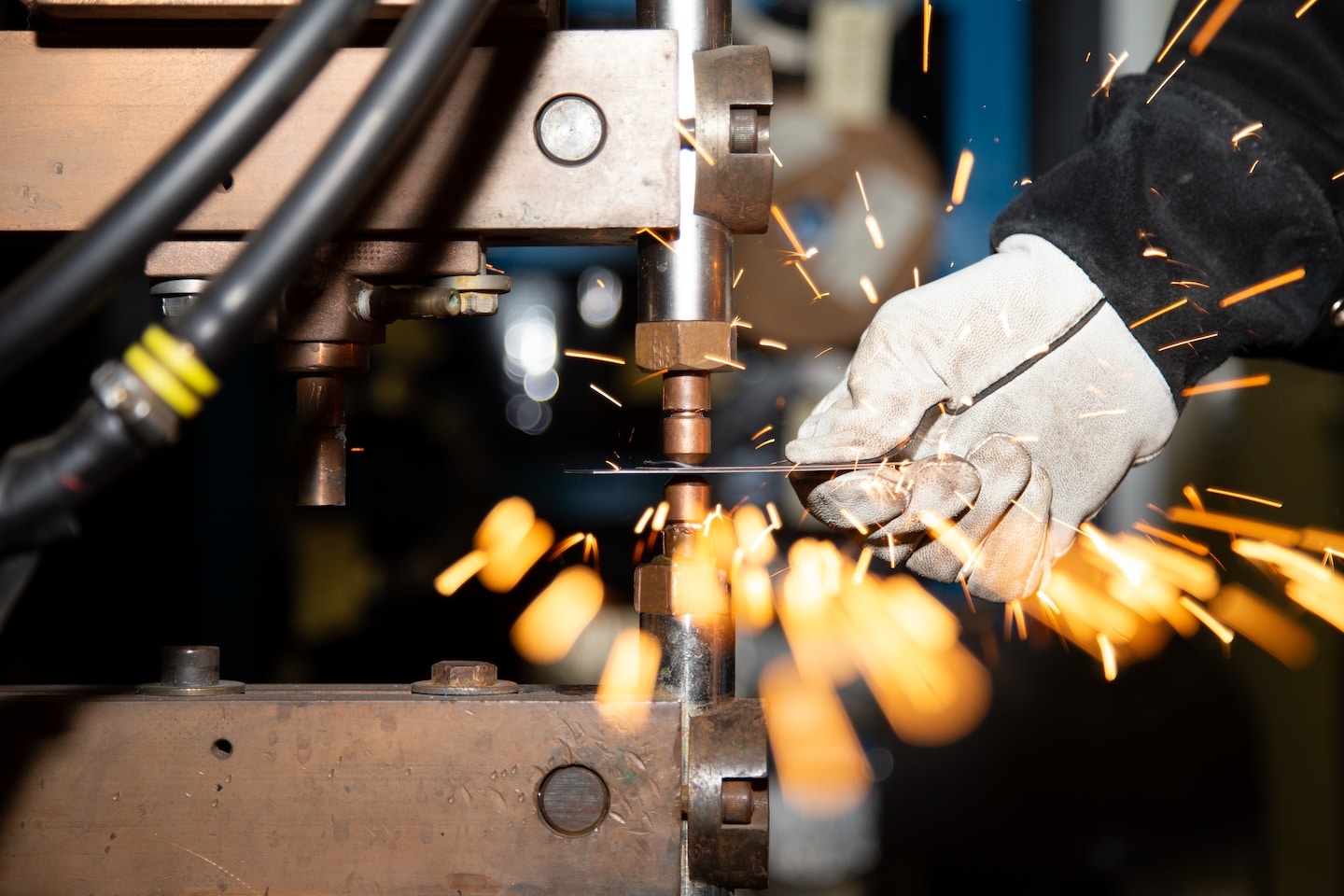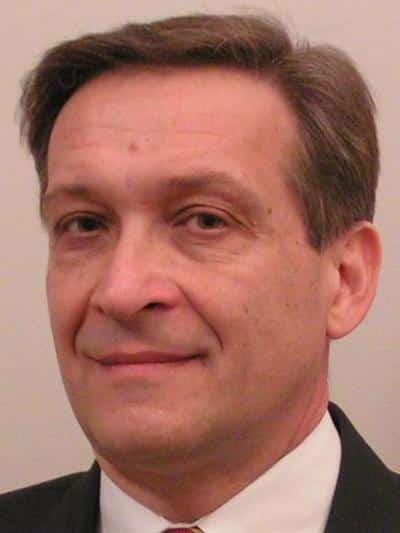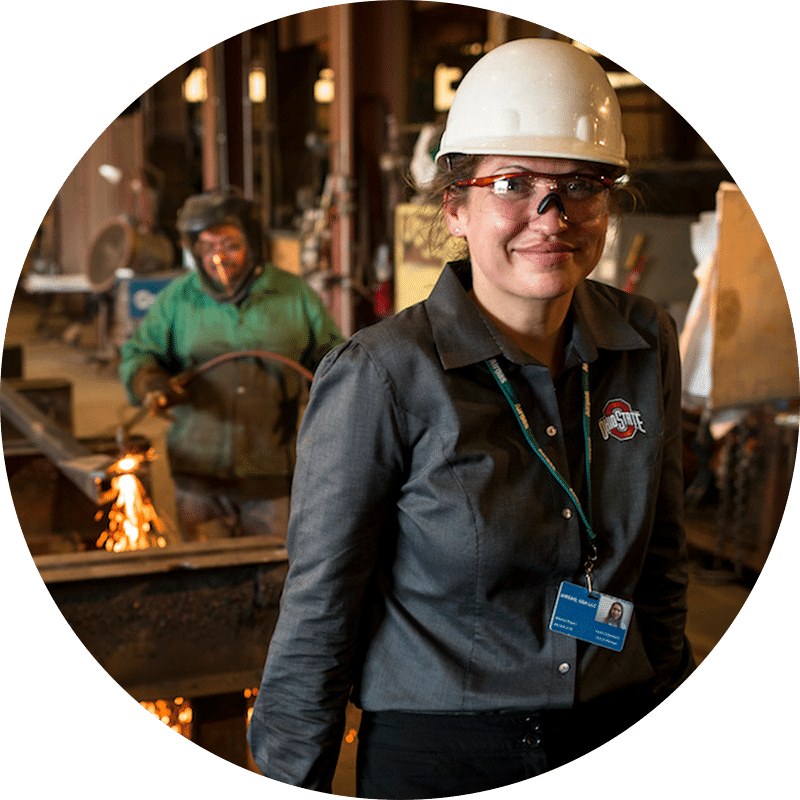Master of Science in Welding Engineering

December 22, 2025
January 12, 2026
Overview
The Ohio State University’s online Master of Science in Welding Engineering program will prepare you to excel in the welding engineering and materials joining industry. In this 100% online welding engineering degree, you will learn from expert faculty with industry experience in welding process development, weldability testing, non-destructive analysis, residual stress and distortion, and more. You will develop the knowledge you need to work with more complex processes and materials, preparing you for more advanced roles in your manufacturing career.
Why earn your online Master of Science in Welding Engineering from Ohio State?
This flexible, fully online welding engineering program is designed for working professionals who have a Bachelor of Science in an engineering discipline and wish to advance their careers. We also welcome students who want to retrain for a welding engineering-related position. To meet the increasing domestic and global demand for welding engineers, Ohio State offers a leading online welding engineering master’s degree program taught by same dedicated engineering experts that teach on our main campus. Ranked #22 in the nation for Best Online Master’s in Engineering by U.S. News & World Report, Ohio State’s online Welding Engineering program has a long history of supplying top-notch welding engineers to the worldwide manufacturing community. First established in 2003, Ohio State continues to equip graduates of this program with the welding engineering expertise to advance their careers.
Frequently Asked Questions
From aircraft carriers to micro-joining for medical devices and electronics, the fact that nearly every segment of our economy depends on materials joining and welding means that you can pursue many exciting career paths. Ohio State Master of Science in Welding Engineering graduates have pursued careers in a wide range of fields such as resistance welding for transportation and marine applications, adhesive bonding for advanced aerospace applications, micrometric wire bonding within electronics, medical device applications, additive manufacturing, and much more.
This Ohio State online welding engineering degree is designed for individuals who are already working in a welding engineering role, have a Bachelor of Science degree in engineering or physical sciences, and wish to achieve a welding engineering master’s degree or obtain graduate credit. This master’s degree may also be applicable for those who wish to retrain for a position related to welding engineering. Working as a welder or in the welding industry does not fit the qualifications for this program. All courses are 100% online and asynchronous, which means you can complete classwork whenever and wherever you need to based on your schedule.
Yes, all applicants to the Master of Science in Welding Engineering program must hold a Bachelor of Science degree in engineering or physical sciences and meet other admission requirements listed on our Admission Criteria tab. Working as a welder or in the welding industry does not fit the qualifications for this program.
Absolutely! The Ohio State University College of Engineering’s online master’s programs are nationally top-ranked by U.S. News & World Report, and you will be learning from the very same expert faculty who teach on our campus in Columbus, Ohio. You will receive the same high-quality education from the comfort of your own home while having the flexibility to complete coursework on your schedule.
This Master of Science in Welding Engineering degree applies to many engineering disciplines and a wide variety of industries. Through the online welding engineering degree at Ohio State, you will gain expertise in materials science, including steels, nonferrous alloys, and polymeric materials, and in process technology, including arc welding, lasers, resistance welding, brazing and soldering, and additive manufacturing. The depth and breadth of knowledge gained in this program opens our students to many rewarding career opportunities.
The Master of Science in Welding Engineering at The Ohio State University is delivered entirely online and all classes are offered asynchronously, offering you flexibility without requiring relocation or travel to campus. This program was designed so that working professionals like you could balance work, life, and education wherever you are in the world.
Once you submit your contact information, a dedicated Enrollment Advisor will connect with you shortly to provide more details about this online program, provide one-on-one guidance, and answer any questions you may have as you navigate the application process.
Related Content
Related Content

Welding engineering alumna Karen Gilgenbach discusses her journey within online learning

Moore Gains Engineering Expertise Through Two Online Programs

What’s the difference between a welder and a welding engineer?
Academic Calendar
Students may apply to enroll in the Ohio State Master of Science in Welding Engineering degree in either Autumn or Spring semesters. The welding engineering online master’s degree does not admit applicants for Summer term admission, as no classes are offered during the Summer term.
Academic Calendar
Students may apply to enroll in the Ohio State Master of Science in Welding Engineering degree in either Autumn or Spring semesters. The welding engineering online master’s degree does not admit applicants for Summer term admission, as no classes are offered during the Summer term.
Admission Criteria
Applicants to the Master of Science in Welding Engineering program must hold a Bachelor of Science degree in engineering or physical sciences and meet other admission requirements listed below.
- An earned baccalaureate (B.S.) degree in engineering or physical sciences from an ABET-accredited college or university by the expected date of entry into the MSWE program.
- Applicants with non-engineering degrees—including welding technology*, math, physics, chemistry, or other relevant fields—must have prior coursework which includes:
– calculus I & II and differential equations,
– calculus-based physics,
– a general chemistry course,
– statics and mechanics of materials, and
– an intro to materials science course. - A minimum 3.0 cumulative grade point average (on a 4.0 scale), or equivalent, in all previous undergraduate work.
- A minimum 3.0 cumulative grade point average (on a 4.0 scale) in all previous graduate work.
- Minimum English language requirement for applicants whose first language is not English.
- The GRE General and Subject tests are not required of our applicants.
- Life experience & certifications: welding training, certifications, and/or work experience cannot be substituted for a Bachelor’s degree.
* Welding Technology— Students who hold a Bachelor’s Technical degree may or may not be qualified for direct acceptance into the degree track.
Still have a question? Contact us at OnlineEnrollment@osu.edu.
Application Materials
- Application
Applicants for admission to the Master of Science in Welding Engineering program must complete an Ohio State Graduate Admissions online application. - Resume
Submission of a CV/resume serves as a helpful means of summarizing the background of an applicant. We will accept either a resume (i.e., a summary of work experience and relevant background) or CV (a longer academic diary that includes all experience, certificates, and publications). Please keep resume length under two pages; the CV may be more than two pages, if necessary. - Academic credentials and transcripts
Copies of transcripts from all educational institutions you have attended must be submitted for degree verification and undergraduate GPA calculation. Unofficial copies can be uploaded in the online application system to form a complete application packet, but official copies of all transcripts (raised seal or notarized) must still be submitted to the Ohio State Graduate Admission’s Office. Note: You do not have to submit transcripts for coursework or degrees received from The Ohio State University. - Letters of recommendation
Please arrange to have three (3) recommendations prepared. These can come from academic or professional connections who are familiar with your qualifications and potential for graduate study. Please contact our team with any questions about potential recommenders. The purpose of these letters is to gain a candid assessment from the recommender about the applicant’s ability to perform well in graduate level course work and carry out research. OSU Admissions requires recommendation letters to be uploaded to the applicant’s file by the recommender; hard-copy references are not accepted. Any letter that appears to have been generated by the student will be considered invalid and will not be accepted by the Graduate Studies Committee. - Statement of Purpose
Please provide a statement of purpose outlining your motivation for attending our program and your goals after receiving the degree. This essay allows you to express your interest in materials science or welding engineering, describe what area(s) interest you the most, and goals that you have for applying the training received here. Since most of the material supplied with the application is little more than numbers, data, and grades, this statement allows you to “speak” to the faculty reviewing your file and gives them a glimpse into your motivations. The statement should be about one to two pages, though there is no set minimum or maximum length. - Nonrefundable application processing fee
A non-refundable $60 fee is required at the time of submission of the application. - Test Scores
A GRE score is not required.

The Ohio State University participates in the State Authorization Reciprocity Agreements (SARA).
SARA is a national initiative that increases student access to distance education courses and programs while maintaining compliance with state regulations. Institutions participating in SARA can offer educational opportunities in all 49 SARA member states, the District of Columbia, the U.S. Virgin Islands and Puerto Rico without seeking individual approval in each state.
California is not a SARA member state, however, OSU may offer online courses and programs to students located in California under the California Private Post-Secondary Act of 2009.
The Application Process
Once you understand your program’s admission criteria, please note the application deadline. You’ll need a quiet space and a variety of materials for your application. To learn more, please see our Admissions page for the full process. Ready to Apply? Find your application here.

Career Outlook
The Master of Science in Welding Engineering degree will broaden your knowledge base and technical skills within the welding discipline that are applicable to a wide variety of industries. If you are looking for a career as an Aerospace Engineer, Biomedical Engineer, Materials Engineer, Mechanical Engineer, or looking to advance your engineering career, then this program will prepare you for advancement.
Top Occupations by Median Income
What They Do
Perform engineering duties in designing, constructing, and testing aircraft, missiles, and spacecraft. May conduct basic and applied research to evaluate adaptability of materials and equipment to aircraft design and manufacture. May recommend improvements in testing equipment and techniques.
Work Activities
Formulate mathematical models or other methods of computer analysis to develop, evaluate, or modify design, according to customer engineering requirements. Plan or conduct experimental, environmental, operational, or stress tests on models or prototypes of aircraft or aerospace systems or equipment. Formulate conceptual design of aeronautical or aerospace products or systems to meet customer requirements or conform to environmental regulations.
Wage Range
- Entry Level: $85,350
- Mid Level: $134,830
- Senior Level: $205,850
Job Outlook
Bright
Projected Growth
6%
Related Careers
- Aerospace Engineering and Operations Technologists and Technicians
- Avionics Technicians
- Electro-Mechanical and Mechatronics Technologists and Technicians
- Mechanical Engineering Technologists and Technicians
- Mechanical Engineers
Job Sectors
- Engineering and Technology
- Mathematics
- Design
- Physics
- Computers and Electronics
What They Do
Develop new or improved designs for vehicle structural members, engines, transmissions, or other vehicle systems, using computer-assisted design technology. Direct building, modification, or testing of vehicle or components.
Work Activities
Conduct or direct system-level automotive testing. Provide technical direction to other engineers or engineering support personnel. Perform failure, variation, or root cause analyses.
Wage Range
- Entry Level: $68,740
- Mid Level: $102,320
- Senior Level: $161,240
Job Outlook
Bright
Projected Growth
11%
Related Careers
- Aerospace Engineers
- Electronics Engineers, Except Computer
- Industrial Engineers
- Manufacturing Engineers
- Mechanical Engineers
Job Sectors
- Engineering and Technology
- Physics
- Mathematics
- Mechanical
- Design
What They Do
Apply knowledge of engineering, biology, chemistry, computer science, and biomechanical principles to the design, development, and evaluation of biological, agricultural, and health systems and products, such as artificial organs, prostheses, instrumentation, medical information systems, and health management and care delivery systems.
Work Activities
Evaluate the safety, efficiency, and effectiveness of biomedical equipment. Prepare technical reports, data summary documents, or research articles for scientific publication, regulatory submissions, or patent applications. Design or develop medical diagnostic or clinical instrumentation, equipment, or procedures, using the principles of engineering and biobehavioral sciences.
Wage Range
- Entry Level: $71,860
- Mid Level: $106,950
- Senior Level: $165,060
Job Outlook
Bright
Projected Growth
7.4%
Related Careers
- Biochemists and Biophysicists
- Bioinformatics Scientists
- Chemical Engineers
- Nanosystems Engineers
- Nanotechnology Engineering Technologists and Technicians
Job Sectors
- Engineering and Technology
- Computers and Electronics
- Mathematics
- Design
- Physics
What They Do
Design, develop, test, and evaluate integrated systems for managing industrial production processes, including human work factors, quality control, inventory control, logistics and material flow, cost analysis, and production coordination.
Work Activities
Estimate production costs, cost saving methods, and the effects of product design changes on expenditures for management review, action, and control. Plan and establish sequence of operations to fabricate and assemble parts or products and to promote efficient utilization. Analyze statistical data and product specifications to determine standards and establish quality and reliability objectives of finished product.
Wage Range
- Entry Level: $70,000
- Mid Level: $101,140
- Senior Level: $157,140
Job Outlook
Bright
Projected Growth
12.2%
Related Careers
- Industrial Production Managers
- Manufacturing Engineers
- Mechanical Engineers
- Mechatronics Engineers
- Validation Engineers
Job Sectors
- Engineering and Technology
- Production and Processing
- Mechanical
- Design
- English Language
What They Do
Evaluate materials and develop machinery and processes to manufacture materials for use in products that must meet specialized design and performance specifications. Develop new uses for known materials. Includes those engineers working with composite materials or specializing in one type of material, such as graphite, metal and metal alloys, ceramics and glass, plastics and polymers, and naturally occurring materials. Includes metallurgists and metallurgical engineers, ceramic engineers, and welding engineers.
Work Activities
Analyze product failure data and laboratory test results to determine causes of problems and develop solutions. Design and direct the testing or control of processing procedures. Monitor material performance, and evaluate its deterioration.
Wage Range
- Entry Level: $68,040
- Mid Level: $108,310
- Senior Level: $172,000
Job Outlook
Bright
Projected Growth
7.4%
Related Careers
- Chemical Engineers
- Industrial Engineers
- Manufacturing Engineers
- Materials Scientists
- Mechanical Engineers
Job Sectors
- Engineering and Technology
- Chemistry
- Physics
- Mathematics
- Production and Processing
What They Do
Perform engineering duties in planning and designing tools, engines, machines, and other mechanically functioning equipment. Oversee installation, operation, maintenance, and repair of equipment such as centralized heat, gas, water, and steam systems.
Work Activities
Read and interpret blueprints, technical drawings, schematics, or computer-generated reports. Research, design, evaluate, install, operate, or maintain mechanical products, equipment, systems or processes to meet requirements. Specify system components or direct modification of products to ensure conformance with engineering design, performance specifications, or environmental regulations.
Wage Range
- Entry Level: $68,740
- Mid Level: $102,320
- Senior Level: $161,240
Job Outlook
Bright
Projected Growth
11%
Related Careers
- Calibration Technologists and Technicians
- Electrical and Electronic Engineering Technologists and Technicians
- Electrical Engineers
- Mechanical Engineering Technologists and Technicians
- Mechatronics Engineers
Job Sectors
- Design
- Engineering and Technology
- Production and Processing
- Mechanical
- English Language
What They Do
Research, design, develop, or test automation, intelligent systems, smart devices, or industrial systems control.
Work Activities
Create mechanical design documents for parts, assemblies, or finished products. Design advanced precision equipment for accurate or controlled applications. Design engineering systems for the automation of industrial tasks.
Wage Range
- Entry Level: $62,840
- Mid Level: $117,750
- Senior Level: $183,510
Job Outlook
Average
Projected Growth
5%
Related Careers
- Electronics Engineers, Except Computer
- Mechanical Engineering Technologists and Technicians
- Robotics Engineers
- Robotics Technicians
- Software Developers
Job Sectors
- Engineering and Technology
- Design
- Production and Processing
- Mechanical
- Mathematics
What They Do
Design, develop, or supervise the production of materials, devices, or systems of unique molecular or macromolecular composition, applying principles of nanoscale physics and electrical, chemical, or biological engineering.
Work Activities
Provide scientific or technical guidance or expertise to scientists, engineers, technologists, technicians, or others, using knowledge of chemical, analytical, or biological processes as applied to micro and nanoscale systems. Supervise technologists or technicians engaged in nanotechnology research or production. Conduct research related to a range of nanotechnology topics, such as packaging, heat transfer, fluorescence detection, nanoparticle dispersion, hybrid systems, liquid systems, nanocomposites, nanofabrication, optoelectronics, or nanolithography.
Wage Range
- Entry Level: $62,840
- Mid Level: $117,750
- Senior Level: $183,510
Job Outlook
Average
Projected Growth
5%
Related Careers
- Bioengineers and Biomedical Engineers
- Chemical Engineers
- Materials Scientists
- Microsystems Engineers
- Nanotechnology Engineering Technologists and Technicians
Job Sectors
- Engineering and Technology
- Physics
- Chemistry
- Mathematics
- Computers and Electronics
What They Do
Design, integrate, or improve manufacturing systems or related processes. May work with commercial or industrial designers to refine product designs to increase producibility and decrease costs.
Work Activities
Troubleshoot new or existing product problems involving designs, materials, or processes. Investigate or resolve operational problems, such as material use variances or bottlenecks. Identify opportunities or implement changes to improve manufacturing processes or products or to reduce costs, using knowledge of fabrication processes, tooling and production equipment, assembly methods, quality control standards, or product design, materials and parts.
Wage Range
- Entry Level: $70,000
- Mid Level: $101,140
- Senior Level: $157,140
Job Outlook
Bright
Projected Growth
12.2%
Related Careers
- Chemical Engineers
- Industrial Engineers
- Industrial Production Managers
- Mechanical Engineers
- Mechatronics Engineers
Job Sectors
- Engineering and Technology
- Production and Processing
- Mechanical
- Design
- Mathematics
What They Do
Design, develop, and evaluate the operation of marine vessels, ship machinery, and related equipment, such as power supply and propulsion systems.
Work Activities
Design complete hull and superstructure according to specifications and test data, in conformity with standards of safety, efficiency, and economy. Supervise other engineers and crew members and train them for routine and emergency duties. Study design proposals and specifications to establish basic characteristics of craft, such as size, weight, speed, propulsion, displacement, and draft.
Wage Range
- Entry Level: $79,700
- Mid Level: $105,670
- Senior Level: $167,660
Job Outlook
Bright
Projected Growth
8%
Related Careers
- Aerospace Engineering and Operations Technologists and Technicians
- Aerospace Engineers
- Mechanical Engineering Technologists and Technicians
- Mechanical Engineers
- Ship Engineers
Job Sectors
- Engineering and Technology
- Mathematics
- Design
- Physics
- English Language
What They Do
Plan, direct, or coordinate activities in such fields as architecture and engineering or research and development in these fields.
Work Activities
Manage the coordination and overall integration of technical activities in architecture or engineering projects. Direct, review, or approve project design changes. Consult or negotiate with clients to prepare project specifications.
Wage Range
- Entry Level: $111,450
- Mid Level: $167,740
- Senior Level:
Job Outlook
Bright
Projected Growth
5.5%
Related Careers
- Electrical Engineers
- Industrial Engineers
- Logistics Engineers
- Mechatronics Engineers
- Project Management Specialists
Job Sectors
- Design
- Engineering and Technology
- Mathematics
- Administration and Management
- English Language
National occupational information in Ohio State Online’s Career Outlook tool is sourced from O*NET Online and the U.S. Bureau of Labor Statistics (BLS). The median annual wage displayed to the right of each occupational title above is based on the BLS Employment Projections program. Outlook and percent change indicate projected growth or decline over the next 10 years.
Curriculum
Ohio State’s 100% online engineering courses allow students from around the world to complete this welding engineering degree with no on-campus requirements. Below is a sample list of some of the courses in this program. All courses are provided asynchronously, meaning you can complete your coursework at a time that works for your schedule.
Study the application of physical principles in engineering of arc welding processes and equipment.
Application of physical metallurgy principles to non-equilibrium thermo-mechanical conditions associated with welding in structural alloys and focus on carbon steels.
Fundamentals of engineering analysis of heat flow, thermal and residual stresses, and fracture and fatigue with applications to design and simulation in welding and manufacturing.
Main concepts of Nondestructive Evaluation of materials as apply to inspections of joints and structures; principles of conventional methods, their capabilities and limitations.
Graduate-level instruction on the theory of temperature, stress, deformation, and phase transformation for additive manufacturing and welding, as well as application of industry-standard simulation codes.
Theory and practice in welding of plastics and polymeric composites, including theory and analysis of welding processes, part and joint design, and process selection.
18 credit hours required. 15 of the 18 credit hours are to come from WELD ENG courses.
Of these 15 credit hours in WELD ENG, at least 6 must be in WELD ENG at the 7000 level or above.
Understanding Online Course Types
As you research the right online program for you, you likely will come across the terms “asynchronous” and “synchronous.” Learn what these terms mean and how they’re important to consider when understanding how a program will fit into your life.
Learn More

Program Faculty

Avraham Benatar
Professor, Materials Science and Engineering
Avraham (Avi) Benatar is a Professor of Welding Engineering within the Department of Materials Science and Engineering and Director of the Plastics and Composites Joining Laboratory. He is also the Coordinator of the Welding Engineering Distance Education Master of Science program and Faculty Director of the College of Engineering Master of Global Engineering Leadership.
Dr. Benatar teaches in the areas of joining of plastics and composites and welding design. His research interests include adhesive bonding and mechanical joining of plastics and composites, fundamentals of plastics and composites welding, optimization and control of welding processes, development of new welding methods, design of welded joints in plastics and composites including the use of moire and speckle interferometry for residual stress measurement, ultrasonic processing of materials, welding design, modeling of brazed joints, and fitness-for-service.
Boian Alexandrov
Research Professor, Materials Science and Engineering
Desmond Bourgeois
Assistant Professor, Materials Science and Engineering
Dave Farson
Associate Professor, Materials Science and Engineering
Carolin Fink
Assistant Professor, Materials Science and Engineering
Xun Liu
Associate Professor, Materials Science and Engineering
Boyd Panton
Assistant Professor, Materials Science and Engineering
Antonio Ramirez
Professor, Materials Science and Engineering
Wei Zhang
Professor, Materials Science and Engineering
Menachem Kimchi
Professional Practice Associate Professor, Materials Science and Engineering
David Phillips
Professional Practice Professor, Materials Science and Engineering
Testimonials
Hear why our graduates chose the Master of Science in Welding Engineering degree at The Ohio State University!
Testimonials
Hear why our graduates chose the Master of Science in Welding Engineering degree at The Ohio State University!
Tuition Fee Overview
Below are the tuition fees you can expect with your program. Estimates are based on the expenses typical of an Ohio State Online student, who would take 6 credit hours each semester as a part-time student, or 8 credit hours each semester as a full-time student in graduate programs. Actual costs may vary.
| Tuition Fees | Per Credit Hour (unless otherwise noted) | Part-Time | Full-Time |
|---|---|---|---|
| Instructional Fee | $829.75 | $4,978.50 | $6,638.00 |
| General Fee | $32.63 | $195.78 | $261.00 |
| Learning Technology Fee | $42.50 | $255.00 (per semester) | $255.00 (per semester) |
| Distance Learning Fee | $100.00 (per semester) | $100.00 | $100.00 |
| Non-Resident Surcharge (if applicable) | $200.00 (per semester) | $200.00 | $200.00 |
| Textbooks & Course Materials | $500.00 (course total) | $500.00 (course total) | $500.00 (course total) |
Tuition fees are subject to change. The table above serves as a guide and not an official bursar’s bill. Full-Time costs are total tuition costs per semester.
Financial Aid Resource
Financial Aid Resource
Related Articles
Related Articles

How to ask your employer for tuition reimbursement
How to Pay for Your Online Program

How to Find and Transfer Prerequisite Courses to Ohio State: A Step-by-Step Guide
Get Started
Connect with a knowledgeable Enrollment Advisor who can help answer your questions and explain different aspects of the more than 80 online degrees and certificates offered at Ohio State. They are here to help you on your education journey.




